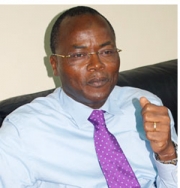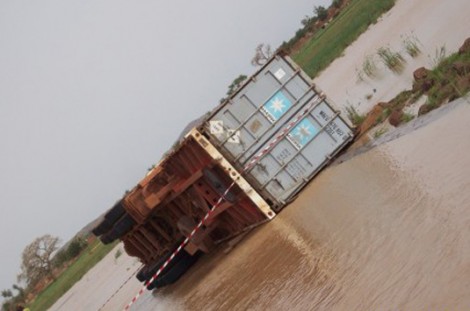Burkina’s gold – who stands to gain?
”I believe that Burkina is about to enter the circle of gold producing countries” the minister of Mining, Quarries and Energy of Burkina Faso, Salif Kaboré, declares in an interview in the daily paper LE PAYS. The minister delivers some interesting pieces of information. But several questions remain unanswered.

 The minister submits the following data: ”In 2010 we produced 24.5 tonnes. If our objective is attained, we will increase to around 27 tonnes this year. This means that somewhere gold mining is expanding. Gold has become our primary export commodity. In 2010 the mining companies brought in 440 billion CFA francs to the State. Gold accounts for 7.28 % of our GDP (Gross Domestic Product). There are also prospects for opening up new mining sites in our country.”
The minister submits the following data: ”In 2010 we produced 24.5 tonnes. If our objective is attained, we will increase to around 27 tonnes this year. This means that somewhere gold mining is expanding. Gold has become our primary export commodity. In 2010 the mining companies brought in 440 billion CFA francs to the State. Gold accounts for 7.28 % of our GDP (Gross Domestic Product). There are also prospects for opening up new mining sites in our country.”
At first sight this is good news for Burkina. Especially when put in context. A look at the 2001 issue of the Atlas du Burkina Faso (Editions Jeune Afrique) shows that from 1996 to 1999 gold production in Burkina remained at around 1 tonne/year and its value was far below its present level..
In recent years gold production has increased rapidly to 5 tonnes in 2008, 11.6 tonnes in 2009, 25.6 tonnes in 2010 and an estimated 27 tonnes this year. Others however, have announced 33.7 tonnes this year and 40 tonnes for 2012. To this must be added that the value of gold has gone up 3.5 times since the 2000-2004 period and twice since 2008. This means that in terms of currency the flow is rising strongly. If the mining companies brought in 440 billion CFA francs to the State in 2010one could hope for 600 billion in 2012.
It is interesting to compare these figures with the totals /./ of the most recent budgets of Burkina:
2009: 919 billion CFA Francs; 2010: 891 billion CFA Francs; 2011 : 1002 billion CFA Francs. It follows that if the gold price continues to remain high, the government will have new opportunities for the coming years.
Who stands to gain from this gold?
The question remains open. One would have thought that for a start (an in order to prevent environmental disasters) the road transport network would become the first recipient, at least for the routes taken by lorries from Ghana transporting cyanide. Indeed, on July 29th this year a truck with a 40 tonne cargo of cyanide turned over and spilled its contents, polluting the dam of Djibo. Press in Burkina told the story: ”It is well known that the poor state of the Djibo dam is the cause of the fall of a truck carrying 40 tonnes /40 000 ??/ of cyanide headed for the Inata mine.”
A few years ago, when cotton production ”was in good health”, roads in the rural areas of the cotton belt were rebuilt. It is hard to understand why the roads used by lorries carrying cyanide to the gold mines in Burkina should not benefit from the profits of gold to make them safe.
 That is not all. LE REPORTER, another Burkinabè publication specialising in inquiries and reporting, has just published the result of their inquiry into the events in the village of Kouna, in the Markoye municipality, near the Ekkassane gold mine. The mine is presently operated by the IAMGOLD company. But in 2008 the company was in the construction stage and came across cumbersome amounts of waste, (discharged by the previous companies that had worked the site before IAMGOLD). The company addressed a question to the public authorities on ”the issue of the waste at CEMOB” (the name given to the discharge mountain). Faced with the silence of the State authorities, the company dismissed the guardian and razed the discharge to the ground a few weeks later. After a couple of months 198 bovines,231 sheep, 321 goats and a camel (according to records of the provincial office of animal husbandry) died of a mysterious illness …/… Today sources (that wish to remain anonymous) within the Ministry of Energy and Mining are categorical on the question of where the heavy metals that poisoned the Kouna dam and caused the death of hundreds of animals came from: IAMGOLD spread the waste found at Essakane into the ”bushland” of Markoye.
That is not all. LE REPORTER, another Burkinabè publication specialising in inquiries and reporting, has just published the result of their inquiry into the events in the village of Kouna, in the Markoye municipality, near the Ekkassane gold mine. The mine is presently operated by the IAMGOLD company. But in 2008 the company was in the construction stage and came across cumbersome amounts of waste, (discharged by the previous companies that had worked the site before IAMGOLD). The company addressed a question to the public authorities on ”the issue of the waste at CEMOB” (the name given to the discharge mountain). Faced with the silence of the State authorities, the company dismissed the guardian and razed the discharge to the ground a few weeks later. After a couple of months 198 bovines,231 sheep, 321 goats and a camel (according to records of the provincial office of animal husbandry) died of a mysterious illness …/… Today sources (that wish to remain anonymous) within the Ministry of Energy and Mining are categorical on the question of where the heavy metals that poisoned the Kouna dam and caused the death of hundreds of animals came from: IAMGOLD spread the waste found at Essakane into the ”bushland” of Markoye.
Is the reason why the owners of these animals have not had any compnsation for their losses that they have not taken to the streets do demonstrate (with violence) in Ouagadougou?
Will the gold of Burkina be a blessing for some and a misfortune for others?
All hope is not gone. The worst is never a certainty.
See also : Le Burkina va-t-il transformer son or en énergie solaire? (Will Burkina turn its gold into solar energy? in French).
Koudougou, September 3, 2011
Maurice Oudet
Director, SEDELAN









